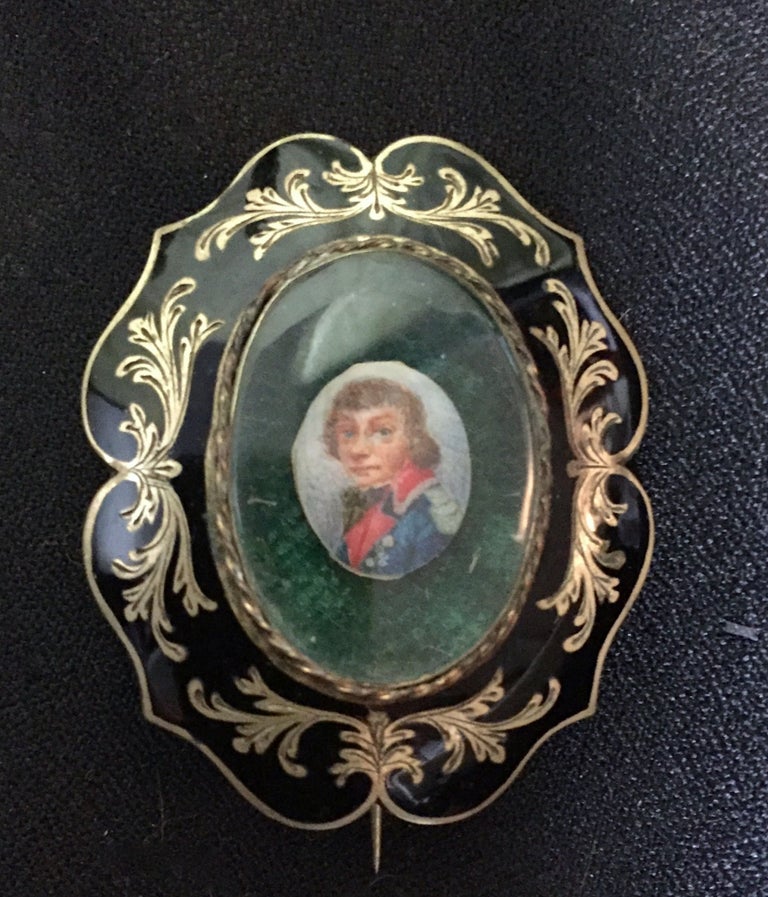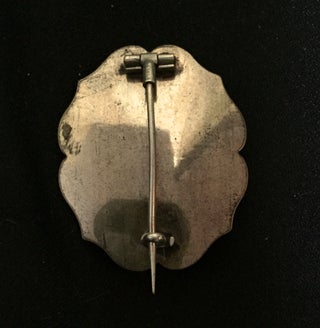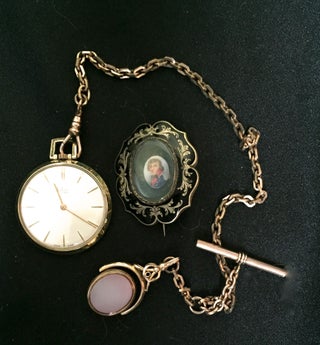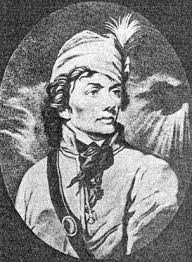MINIATURE PORTRAIT of GENERAL TADEUSZ KOSCIUSZKO; finger-ring watercolor portrait reset in brooch
America or Europe: Polish School, ca.1795. Polish School miniaturist. original. Victorian silver-and-enamel brooch with gold back. Portrait miniature--head & bust--of Tadeusz Kosciuszko: watercolor (image: 1.4 x 1 cm / 0.6" x 0.4"; framed: 4.1 x 3.5 cm /1.6" x 1.4") executed on natural material; wearing a military uniform (blue body cloth with red trimmed collar & red sash with silver epaulettes.
Because Tadeusz Kosciuszko was made a "Brigadeer General" in the American Revolution and a "Major General" in the subsequent Russo-Polish conflicts, his silver epaulettes and our provisional dating convey the high and prestigeous rank of "General"--an impression reinforced by three medals that are depicted on Kosciuszko's breast. Portrait: Very Good / Frame: Very Good +. Item #1898
Formerly a miniature watercolor portrait set into a male finger-ring, this delicate minature of General Tadeusz Kosciuszko (1746-1817), the famous hero of the American Revolution, Polish-Russian War of 1792 and the Revolt of 1794, has been reset into a Victorian brooch whose front has been made of silver-and-enamel with a green fabric background, glass dome, with gold back & pin.
(Pressing the evidence: The tiny blurred image of the central medal on the chest of Kosciuszko is possibly suggestive of the enameled gold Eagle of the Society of the Cincinnati (founded in 1783) that George Washington (d.1799) awarded Kosciuszko.
See the colored portrait by Karl Gottlieb Schweikart (1772-1855)--from Wikipedia and our image #4--which was executed in 1802 and depicts the Eagle award. Schweikart's portrait is, of course, much more refined and larger than our miniature, but the pose and age of the subject are rather similar, as are aspects of the uniform: red collar, medal(s) &/or buttons, and silver epaulette.
Exceptional quality -- especially considering its micro size of 1.3 x 1 cm, or approximately a 1/2-inch oval!
Andrzej Tadeusz Bonawentura Ko ciuszko (1746-1817; his surname is roughly pronounced "Kos-CHOOS-ko") was a Polish military engineer and a highly skilled military leader who became a national hero in Poland, Lithuania, and the United States. He fought in the Polish–Lithuanian Commonwealth's struggles against Russia and Prussia, and on the American side during the American Revolutionary War. He worked closely with General George Washington, who was eager to use Kosciuszko's skills as a military engineer. Subsequently, as Supreme Commander of the Polish National Armed Forces, he led the 1794 "Kosciuszko Uprising."
In 1776, Kosciuszko moved to North America, where--over an 8-year period--he took part in the American Revolutionary War as a colonel in the Continental Army. He fought in the battle of Fort Ticonderoga and executed the plans for the pivotal battle of Saratoga in New York. An accomplished military engineer, at Washington's request, he designed and oversaw the construction of several superior fortifications, including those at West Point, New York. The latter became the largest fort in America and took two and one half years to construct. Kosciuszko felt that it was his finest achievement. In 1783, in recognition of his services, the Continental Congress promoted him to brigadier general and made him a citizen.
Returning to Poland in 1784, Kosciuszko was commissioned a major general in the Polish–Lithuanian Commonwealth Army. After the Polish–Russian War of 1792 had resulted in the Second Partition of Poland, he organized an uprising against Russia serving as its Naczelnik (commander-in-chief). Russian forces captured him at the Battle of Maciejowice in October 1794. The defeat of the Kosciuszko Uprising led to Poland's Third Partition in 1795, which ended the Polish–Lithuanian Commonwealth's independent existence for 123 years.
In 1796, pardoned by Tsar Paul I, he emigrated to the United States. A close friend of Thomas Jefferson, with whom he shared ideals on human rights, Kosciuszko later abolished serfdom in Poland via the so-called "Manifesto of Polaniaec" and tried to enable peasants to own the land they worked. Jefferson said of him: "He was as pure a Son of Liberty as I have ever known."' The Polish-American hero also wrote a will dedicating his American assets to the education and freedom of U.S. slaves. Regrettably, the execution of his will proved difficult--Thomas Jefferson had been named as executor--and the funds were never used for the purpose he had intended.--adapting Wikipedia and other references.
Condition: Very Good. Currently set into a Victorian brooch made of silver and enamel. Probably "Polish School" for creator.
Our images show other portraits of this military-and-political hero.
Illustrated gold watch with chain & fob is for illustrative purposes to suggest scale and is not included in sale of miniature portrait.
Price: $4,750.00







